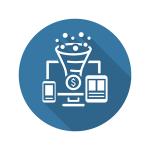
When sales people call or e-mail to say they’re just “touching base,” customers and prospects know exactly what they mean. It’s a nudge to see if they’re any closer to making a decision on a purchase. The risk, of course, is that if you touch base one too many times, customers may decide you’re way off base in terms of conducting yourself appropriately.
To some extent, the real art is not in the first follow-up — customers and prospects expect that. It’s that second follow-up — the one that happens when the salesperson doesn’t receive that initial reply and wants to keep their pipeline moving along. How you approach that second or even third follow-up could make the difference between closing the deal or having a customer close the door.
First, here’s what not to do. Don’t use the same script over and over, or simply forward an email you already sent as though the customer has been delinquent and has an obligation to get back to you.
This is where effective use of a CRM solution can be a game-changer for Canadian SMBs, because if you make the most of the data at your disposal, you can make follow-ups more strategic and successful.
Here are five tips to help you master the follow-up and close the deal:
Align Your Follow-up Tactics With The Buyer Journey
Make sure the first meeting with a customer or prospect captures as much as possible about the typical cycle or processes they go through in order to make a purchase. For example, are they the final decision-maker or does a deal need to go through additional layers of discussion and approval? Many B2B firms are recognizing the reality of account-based selling, and power CRM users plan their approach accordingly. How often does the buying team meet, and when, for instance? Following up the day after that meeting takes place will be far more effective than reaching out blindly.
Use Content That Moves The Conversation Forward
What initial questions or objections did customers raise in that first meeting? Align that data in your CRM to what the marketing department might already have created in terms of white papers, blog posts, data sheets or other collateral to see where you can either answer those questions or even offer further education to the customer. Leading with content like this will seem less like a traditional follow-up but more like evidence you were really listening the first time.
Match Communication Channels To Behaviours
Sometimes sales pros make the mistake of following up first by e-mail, then leaving a series of voice mail messages if the e-mail doesn’t get a reply. Or the reverse happens, and an unreturned voice mail turns into a nagging e-mail chain. Either way, customers will be likely to ignore, hit “delete” or likely both. Instead, examine data that indicates preferences in communication channels. If the customer or prospects tends to prefer the urgency of a phone call, stick with the phone. If sending e-mail back and forth gives them more time to think (or consult with their buying team), stick with e-mail. If it’s a more regular customer and past history shows the sale progresses from voice mail to e-mail, follow the pattern.
Show Up Where Customers Do
Don’t mistake “social selling” as something that only happens in the early stages of the buyer journey. If you’re following customers and prospects on social media, contribute to conversations they might have on those services, whether it’s offering an original insight or merely sharing a link to a helpful article or blog post. This may be one of the most subtle follow-ups of all — just by being present you’ll remind them of where they’ve left off with you.
Demonstrate Awareness And Support
Browse online and you’ll see all kinds of templates for sales people to use that supposedly make follow-ups effortless. It’s far better to be as personal and specific as possible, especially if this isn’t your first follow-up. Has the customer’s company been in the news recently? Congratulate them on launching a new product or service. Has a new issue cropped up in their sector? Offer your thoughtful take on it and encouragement for what they might be going through.
Follow-ups may be a delicate matter, but by the second attempt, you need to show customers and prospects you’re not just another sales professional, but a trusted advisor who understands them, their business and who makes them feel like more than just a lead.
Get more sales tips to fuel your success in 2016 and beyond in Saleforce’s free eBook:


























